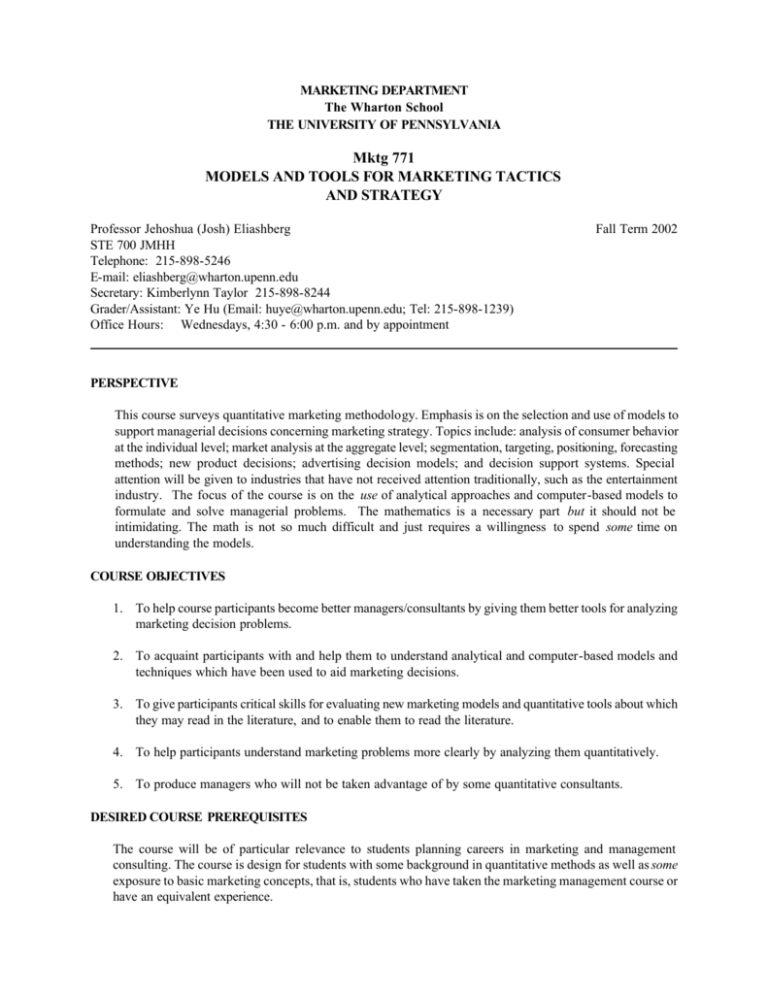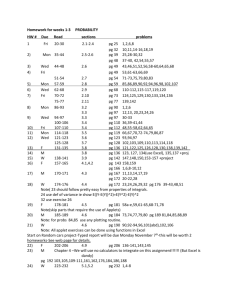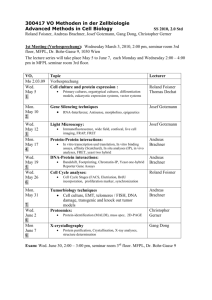Mktg 771 Eliashberg
advertisement

MARKETING DEPARTMENT The Wharton School THE UNIVERSITY OF PENNSYLVANIA Mktg 771 MODELS AND TOOLS FOR MARKETING TACTICS AND STRATEGY Professor Jehoshua (Josh) Eliashberg STE 700 JMHH Telephone: 215-898-5246 E-mail: eliashberg@wharton.upenn.edu Secretary: Kimberlynn Taylor 215-898-8244 Grader/Assistant: Ye Hu (Email: huye@wharton.upenn.edu; Tel: 215-898-1239) Office Hours: Wednesdays, 4:30 - 6:00 p.m. and by appointment Fall Term 2002 PERSPECTIVE This course surveys quantitative marketing methodology. Emphasis is on the selection and use of models to support managerial decisions concerning marketing strategy. Topics include: analysis of consumer behavior at the individual level; market analysis at the aggregate level; segmentation, targeting, positioning, forecasting methods; new product decisions; advertising decision models; and decision support systems. Special attention will be given to industries that have not received attention traditionally, such as the entertainment industry. The focus of the course is on the use of analytical approaches and computer-based models to formulate and solve managerial problems. The mathematics is a necessary part but it should not be intimidating. The math is not so much difficult and just requires a willingness to spend some time on understanding the models. COURSE OBJECTIVES 1. To help course participants become better managers/consultants by giving them better tools for analyzing marketing decision problems. 2. To acquaint participants with and help them to understand analytical and computer-based models and techniques which have been used to aid marketing decisions. 3. To give participants critical skills for evaluating new marketing models and quantitative tools about which they may read in the literature, and to enable them to read the literature. 4. To help participants understand marketing problems more clearly by analyzing them quantitatively. 5. To produce managers who will not be taken advantage of by some quantitative consultants. DESIRED COURSE PREREQUISITES The course will be of particular relevance to students planning careers in marketing and management consulting. The course is design for students with some background in quantitative methods as well as some exposure to basic marketing concepts, that is, students who have taken the marketing management course or have an equivalent experience. ASSIGNED READINGS Required text: Marketing Engineering: Computer-Assisted Marketing Analysis and Planning by Lilien and Rangaswamy (LR), 2nd Edition, Prentice Hall, 2002. Recommended additional text: Marketing Models, by Lilien, Kotler, and Moorthy (LKM), Prentice-Hall, 1992 (book on reserve at Lippincott Library). All assigned readings for the course are available in a Bulk Pack (BP) at Wharton Reprographics. Your readings packet contains journal articles, which describe various models. In this course you will be required to read them for basic understanding, not for mathematical detail. Beyond this course you will be exposed to models in this form, and the experience gained in digesting the material and filtering it for ideas will be invaluable. Besides, this packet will act as the nucleus of a models reference library when, in the field, you are called upon to solve a quantitative problem. COURSE GRADING Your final grade in the course will be based on the following criteria and weights: Group project and presentation Individual assignments Class participation/attendance 50% 30% 20% ASSIGNMENTS The course will involve two types of assignments: individual take-home assignments and a major group project. The take-home assignments are designed to provide running examples of the various concepts and methods introduced in the course and, secondarily, a means for assessing student progress. I have currently planned three assignments throughout the semester; however, this may be altered depending on the group's progress and interests. Late homework assignments will not be accepted. The major group project is the primary evaluation tool in the class. Its structure is straightforward: the class will be divided up into teams of no more than three members each. The objective of the project is to develop a new procedure and/or apply one of the methods or models covered in the course to an actual marketing decision problem. This project involves a written and oral presentation and a term paper, which is due on December 9, 2002. When the project is presented to the class (during the final two sessions), the class will act as if it is a firm's marketing committee. The presentation typically consists of a description of the model or technique in non-mathematical terms and the team's evaluation of its impact, strengths, and weaknesses for helping the manager. It is strongly recommended that you start thinking about a research problem at the very beginning of the course. Feel free to discuss with me any ideas that you may have. CLASS PARTICIPATION/ATTENDANCE Class sessions will be devoted to probing, extending, and applying the material in the readings and the cases. It is your responsibility to be prepared for each session as detailed in the course outline. I believe that each of you will benefit from belonging to a “study group” that meets and prepares for each session before coming to class. 2 Each of you is expected to contribute to class discussions. To do well, you must learn from active participation in presentations and class discussions. In evaluating class participation, I emphasize the quality of participation. In particular, I will try to assess how your contributions enhance both the content and process of a discussion along the following lines. § Do the comments add to our understanding of the issues or are they frivolous – an attempt to get “air time” that day? (i.e., you have only one thing to say and want to say it no matter how irrelevant it is to the ongoing discussion). § Are the comments timely and linked to the comments of others? § Do the comments move the discussion along by giving a new perspective? § Are the comments clear and concise, or obscure and rambling? § Do your comments provide new insights? § Do the comments reflect a concern for maintaining a constructive and comfortable classroom atmosphere? If you are unable to attend a particular session, please inform me as early as possible. If you attend, but are unprepared to participate in the day’s discussion, notify me prior to the beginning of the class to avoid any embarrassments. There will also be a number of guest lecturers who will share perspectives into the practice of modeling. Please note that there may some changes in the dates they are scheduled to visit the class. SOME SUGGESTIONS FOR THE TERM PROJECT You are free to select any marketing problem that concerns you and appears capable of interesting and useful rigorous model implementation. Think of the problem in connection with an actual company or industry. Your paper should have three parts: 1. Background of the problem and relevant literature 2. A proposed model and/or solution to the problem 3. Evaluation of the model and proposed further work For example, you can develop a model of market potential estimate and sales forecast for some market that interests you (for example, automobiles, coffee, toothpaste, banking, and so on). Study pertinent publications for background information about the industry. Your main interest should center on how company sales are determined and can be forecasted in this market. In this type of project you will be expected to validate the prediction of your model by using actual data. 3 Some sample projects completed in recent years: § Forecasting sales for four PC software applications § Estimating demand for a new citrus fruit § Modeling students’ choices of music records § Pricing in the home video industry § Modeling consumer trade-offs for video home viewing services § Sales forecasting for Host Marriott § Demand forecast for household on-line services § Modeling accurate response in the musical instrument business § Predicting the penetration of digital tape technologies § Assessing the market share for a new basketball shoe § Estimating the business opportunity of pay-per-view boxing events Your final paper should be typewritten, no longer than twenty pages in total (including exhibits and other attachments), double-spaced, one side. It should be handed in on December 9, 2002. The term paper will be graded mainly on the following criteria: 1. Originality in developing new methods or mathematical formulations of marketing problems; 2 Degree of developing an operational model for some standard marketing problem; 3. Amount of research, digging, and topic development; 4. Critical and knowledgeable use of concepts and techniques; 5. Quality of paper's organization, clarity, and writing style. It is highly desirable for you to: 1. Form a project team as early as possible; 2. Decide on your term paper topic as early as possible; 3. Review some old projects available in my office; 4. Get clearance from me; 5. Discuss the progress on your paper with me at least once during the semester at an office appointment or during the course break. 4 Marketing 771 J. Eliashberg Course Schedule Date Mon. Sept 9 Wed. Sept. 11 Sessio n 1 2 Mon. Sept. 16 Topic, Readings, Cases, Assignments Introduction • • • LR Objective of this course What you will learn in this course Course administrative issues Marketing Problems and Marketing Models Reading • “Models and Managers” • “Building Marketing Models that Make Money” • “Implementing and Evaluating SILVERSCREENER”(just skim it) Ch.1 No Class Wed. Sept. 18 3 More on Problems and Models: The Case of Product /Service Positioning Ch.4, pp. 95-104 Mon. Sept 23 4 Perceptual Maps and Factor Analysis: The Fundamental Idea Reading: “Analyzing Consumer Perceptions” Due List of Group Members Ch.4, pp.104-113 Wed. Sept. 25 5 Factor Analysis: Interpreting the Output Reading • “Motion Picture Attendance” • “Movie Genres: Toward a Conceptualized Model” Mon. Sept. 30 6 Preference Models Conjoint Analysis: The Basic Idea Reading: • “ Conjoint Analysis” Wed. Oct. 2 7 Conjoint Analysis: Interpreting the Output Static Market Share Models Reading: “Thirty Years of Conjoint Analysis” Case: “MSA: The Software Company” Mon. Oct. 7 8 Preparing the Inputs for Running Factor Analysis and Conjoint Analysis Wed. Oct. 9 9 Dynamic Market Share Models Due One page problem definition 5 Ch. 7, pp. 184-194 Date Mon. Oct. 14 Sessio n 10 Topic, Readings, Cases, Assignments LR Wed. Oct. 16 11 More on Market Analysis for New Products/Business Opportunities Mon. Oct. 21 12 Guest Speaker (tentative) Wed. Oct. 23 13 Forecasting Models: An Overview Mon. Oct. 28 14 Market Penetration Models: The Bass Model • Formulation • Use • Estimation Reading: “A New Product Growth Model” Wed. Oct. 30 15 More on the Bass Model Extensions and Other Dynamic Models How to Use the Software Reading • “Diffusion Models: Managerial Applications and Software” • “A Parsimonious Model for Forecasting Gross Box-Office Revenues of Motion Pictures” Mon. Nov. 4 16 Guest Speaker (tentative) Wed. Nov. 6 17 Projects Progress Reports: Group Presentations Due Presentation slides Mon. Nov. 11 18 Overview: New Products-Related Problems and Models Case “Johnson Wax: Enhance (A) Case” Ch. 7, pp. 178-184 Wed. Nov. 13 19 The Assessor Model Decision Trees Models Reading “The Value of Marketing Research Information” Case “The Williams Company” Ch. 7, pp. 204-211 Mon. Nov. 18 20 The Assessor Model/Decision Trees: How to Use the Software Wed. Nov. 20 21 Expert vs. Decision Support Systems Reading • “A Knowledge-Based System for Advertising Design” • “Developing Marketing Expert Systems” • “Hard Up for a Plot? Get With the Program” Market Analysis for New Product/Business Opportunities Case: E.T.Phone Home 6 Ch. 7, pp. 195-202 Ch. 8, pp. 238-245 Date Mon. Nov. 25 Sessio n 22 Topic, Readings, Cases, Assignments Models and Modeling Needs in the Entertainment Industry Reading • • • Wed. Nov. 27 23 Mon. Dec. 2 24 “Predicting Success of Theatrical Movies: An Empirical Study” MOVIEMOD: An Implementable Decision Support System for Pre-release Market Evaluation of Motion Pictures” “Implementing and Evaluating SilverScreener” Projects Consultation in Class Summary, Review, The Future Reading: “Models to Bits: Decision Models for the Digital, Networked Economy” Wed. Dec. 4 25 Projects Presentations Mon. Dec. 9 26 Projects Presentations Due Group Projects Reports 7 LR University of Pennsylvania The Wharton School Mktg 771 Professor Jehoshua (Josh) Eliashberg Fall 2002 Table of Contents Articles: A1. A2. A3. A4. A5. A6. A7. A8. A9. A10. A11. A12. A13. A14. A15. A16. A17. A18. Models and Managers: The Concept of Decision Calculus Building Marketing Models that Make Money Implementing and Evaluating Silver Screener: A Marketing Management Support System Analyzing Consumer Perceptions (HBS# 9-599-110) Motion Picture Attendance: A Market Segmentation Approach Movie Genres: Toward a Conceptualized Model and Standardized Definitions Conjoint Analysis (HBS# 590-059) Thirty Years of Conjoint Analysis: Reflections and Prospects A New Product Growth Model for Consumer Durables Diffusion Models: Managerial Applications and Software A Parsimonious Model for Forecasting Gross Box Office Revenues of Motion Pictures The Value of Marketing Research Information A Knowledge-Based System for Advertising Design Developing Marketing Expert Systems: An Application to International Negotiations Hard Up For a Plot? Get With the Program Predicting Success of Theatrical Movies: An Empirical Study MOVIEMOD: An Implementable Decision Support System for Pre-release Market Evaluation of Motion Pictures Models to bits: Decision models for the digital networked economy Cases: C1. C2. C3. C4. MSA: The Software Company (590-069) E.T. Phone Home Inc.: Forecasting Business Demand (583-121) Johnson Wax: Enhance (A) (583-046) Case 1.2: The Williams Company 8 Group Project Self-Evaluation Form The purpose of this evaluation form is to communicate the contribution of each individual in the group. Do this by allocating points among group members: give more points to individuals who did more work or for some reason deserve more credit; give less points to individuals who did less work or for some reason deserve less credit. The total points available for the entire group including yourself is 100. Therefore, if there are five members in your group, and if you feel that each member did their fair share of the work, then give 20 points to each member. If you give one or more members more than 20 points, then one or more other members must receive less than 20 points. I will consider confidentially all of the evaluations turned in by the group and any other relevant information that emerges during the term in assigning points for the Individual Effort component of the project. (Of course, you may as a group decides jointly how you will make the point allocations, if you so desire.) Project Title: Group Member Your Name: Other Members: Comments (if any): 9 Points







